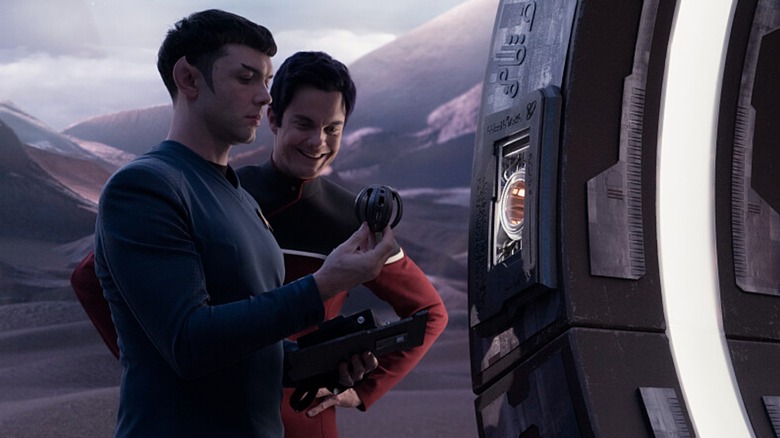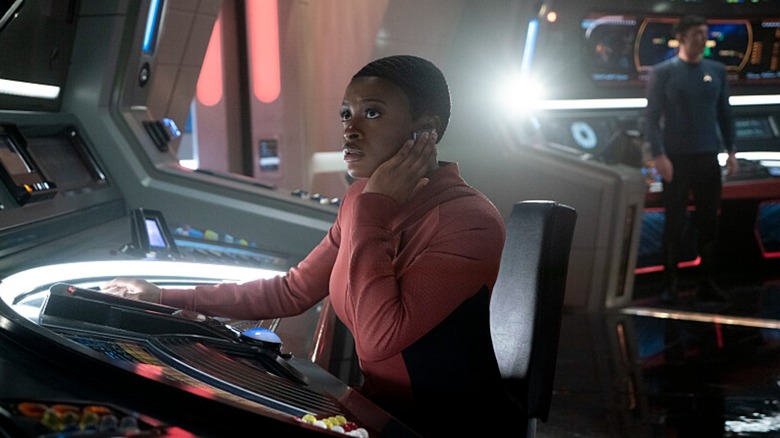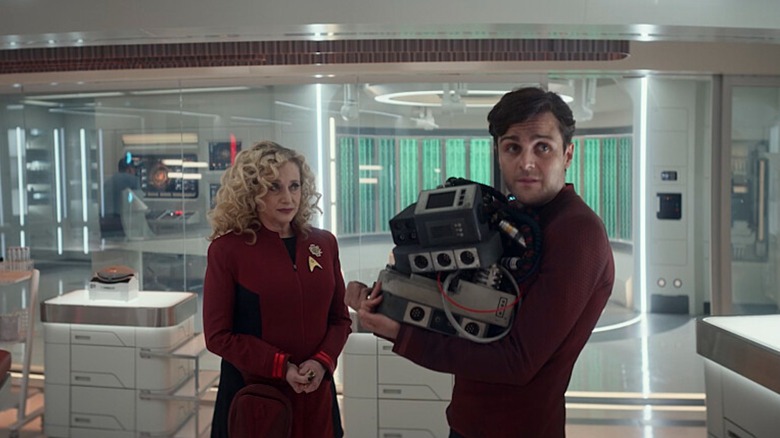Strange New Worlds' Futuristic VFX Tech Has A Delightful Star Trek Nickname
A Variety cover story about the future of "Star Trek" includes plenty of exciting updates about the future of the series, but it's also just a trivia treasure trove for "Trek" fans — including the ones who work on the shows. "Star Trek: Strange New Worlds" stars Anson Mount (who plays cool, calm, and collected Captain Pike in the series) and Ethan Peck (who plays a younger, slightly more emotive Spock) both noted how surreal their jobs are, while Mount also revealed that they get to go to work on a set named after part of a starship.
"Sometimes we call it The Holodeck," Mount told Variety when describing the massive augmented reality walls (similar to those used by Industrial Light & Magic's The Volume) that turn the set into a virtual-physical hybrid space. Variety's Adam B. Vary observed that Mount "[couldn't] help but break into a boyish grin" when he talked about the AR walls they call The Holodeck, as if it's yet another childhood dream come true. In an interview with Entertainment Tonight back in 2019, Mount explained that he'd been a "Star Trek" fan since he was seven or eight, and said of his own casting, "It was almost like you had been sitting in the audience for a really long time and somehow you get sucked into the screen and then you're standing in the starship in front of a Klingon with a phaser in your hand."
The AR walls on set are nicknamed The Holodeck
The Holodeck title apparently isn't just a nickname among the actors; according to Variety, posters of the holodeck from "Star Trek: The Next Generation" adorn the walls along the path to the virtual set, along with the phrase "Enter Holodeck" written in a classic "Star Trek" font (though, sorry font geeks, there's no word on whether it's Galaxy or Horizon). As with other virtual sets being used in Hollywood today, the AR walls known as The Holodeck utilize massive LED screens that display highly realistic, kinetic CGI backdrops. Mount says they're a bit dizzying.
"The images on the walls start to move in a way that makes no sense," the actor told Variety. "You end up having to focus on something that's right in front of you so you don't fall down." Peck, meanwhile, said he's not as bothered by the CGI walls, and wished he could take one of the Holodeck signs home. "I don't really get disoriented by it. Spock would not get ill, so I'm Method acting," he joked.
Virtual sets still need the human touch, and Trek's got it
While virtual sets were initially praised as a technology capable of revolutionizing film and television, it's become clear by now that not every production is made better by AR walls. "The Mandalorian" set the standard by coupling its realistic set graphics with great production design and cinematography, but movies like "Thor: Love and Thunder" (which didn't quite hit the background/prop ratio needed to look real) and shows like "Percy Jackson & The Olympians" (which, as the first production to use the Vancouver-based virtual set, has an uncanny valley shininess to it) prove it's not enough to let the sets do the work, no matter how magnificent — and disorienting — they are.
Luckily, though, "Star Trek: Strange New Worlds" seems to be firing on all cylinders. The first two seasons look great, and everyone from the costume department to the director's chair delivers the goods again and again. As "Trek" star turned director Jonathan Frakes put it elsewhere in the article, "Every department has the resources to create." We can't wait to see what they'll create next.
"Star Trek: Strange New Worlds" will return for season 3 on Paramount+ in 2025.


